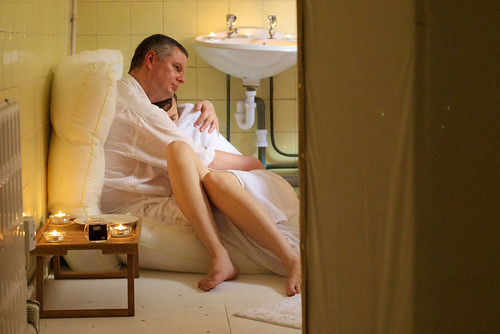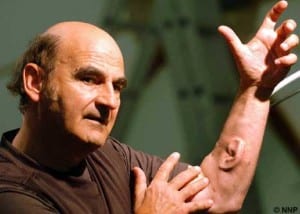The performance day had finally come, there was a good turnout and it appeared that the performance went well. Due to the content of our performance, we each had a very different experience, below are each of our responses;
Jordan Tallis’ Response
Exploring contemporary experimental performance was somewhat new and alien to me. From the very beginning of the module I found myself baffled as to how taking the simplest of things such as sitting next to someone became a work of art. It wasn’t until looking in depth at such moments that I began to question the complexity of the things we do have and the profound effect they can have on others. I believe performance art itself is a way to unmask hidden things that are never really explored on a day to day basis. Intimacy itself is one of those concepts that has never been truly defined, a lot of people associate intimacy as a sexual experience, when really you can be intimate with almost everyone we come in to contact with. Boundaries and limitations are the only real ways we categorize intimate moments with people. Performance art is in no way a drama, as we are not acting (being someone else), we are performing. The moment the first person during our performance sat down next to me, a lot of thoughts began to come into my head. Which was just ‘to be myself’, I kept contemplating on how to deliver my line, but the more I thought about it the more I found myself becoming a lot more tense. I did believe to keep myself as natural as possible the only thing to do was try not to think and relax into the performance.
The atmosphere itself because it was dark with dimmed spot lights and a larva lamp enabled me to sink into my seat, allowing myself to feel at ease and in an intimate mood. I had noticed I had to use my peripheral vision as I was faced forward towards the larva lamp and had very little awareness of people coming closer to sit down next to me. I felt at times becoming a little tense as I had no awareness if people were coming or going. When they sat down next to me I felt very comfortable, in fact the longer they stayed the more I found they moved up towards me or I moved up towards them, and it didn’t in the slightest feel awkward, it felt natural.
Jessica Smith’s Response
Performance art was something that I had never experienced, before this module, let alone taken part in. I was a little nervous at the beginning as I was not entirely sure what to expect. However, throughout the process I started to feel more comfortable with it. This could be due to all of the different pieces that we sampled and when our performance came around I felt completely relaxed and confident about it. The fact that all of the other performances we have viewed/taken part in were so vastly different made me understand that although our questions did matter, the topic that we decided to explore did not matter. It was also how we answered the questions that mattered. I feel that our idea really paid off as we thought about every little detail, such as the aesthetics of the piece. It was the small specifics that made it what it was. If we were to take away any aspect, like the sound, the lighting, the lava lamp or the way that the performance was set out, then the piece would not have been the same. This is mainly due to the fact that without these things it felt more awkward than intimate.
In my particular section, during the performance, there were a few things that surprised me. For example, the most intimate I personally felt was when an audience member stroked my hand after I had done that to them. It made me feel that they were there simply because they wanted to be and that they wanted the same feelings that we were aiming to get. This surprised me just because on the surface it seems like such a mundane act, which is also how I thought about it. However, when they did it I realised that there is a lot more to it. It shows that they are actually present and in that moment they are thinking of only you and your feelings, rather than just feeling like they have to be there to support their peers.
Another thing that shocked me was that the same thing (holding hands in this instance) can feel completely different with one person to another. When people sat with me I did not look into their eyes, instead I would just glance at them occasionally. In our first rehearsal we tried it where I looked into their eyes but it did not feel right or intimate, it just felt weird and unnatural. However, two people, I did not know either of them, held eye contact with me. With the first person it felt the same way it did in the rehearsal. Yet, with the second person it felt natural and comfortable. I am not entirely sure why this was but I think it was down to the fact that the second person did not seem to see this as a performance which made the atmosphere between us less tense as the first person.
Leanne McKettrick’s Response
This performance was a completely different experience to any performance I had done in the past, and I think this is due to the fact that the context behind the performance was completely different. This wasn’t the kind of performance I was used to, my ideas had always been that “performance conjures expectations of theatre. Performativity is associated with preparation, presentation, script, symbolism, props, drama” (Papacharissi, 2011, p.1). This performance differed as it was performance art, something which I had only discovered through this module. In the majority of performances that I have been a part of throughout university, I have always had a part to play, a character, so in essence it has never been me taking part in the performance, but the character I was playing. However, this piece was completely different, I wasn’t being someone else, I was being me. It was only as we, all sat in place, waiting for the first audience member to take place that I realised this and from then the performance entirely changed for me. It was like I had allowed myself to be myself, and then I didn’t feel nervous but as people approached me I responded as I would, open and friendly.
This touches upon the post about commitment, by being myself I was able to commit far much more to the audience than I would as a character, as my actions were all genuine. Throughout the rehearsals, I had always wanted the audience to leave feeling that they had just been a part of a meaningful encounter, and I sincerely hope that my sudden change in attitude had aided this, because the experience was very meaningful to me.
I left the performance feeling like I finally understand a little about contemporary experimental performance. This is performance art, and the difference from this and drama, is that unlike drama, this isn’t acting or being a character, essentially it is about being and the question which come from that.
Demi Morrison’s Response
Performance Art is the term I would use if now asked to categorize our work. This is something that was completely new to me until I came to university. Goldberg argues that “the term performance art has become a catch-all for live presentations of all kinds” (2001, P.225), which highlights one of the reasons I was nervous and excited when attempting this work; because we had so much scope. All I had ever done before was improvising and devising with scripts written by people such as Shakespeare. Therefore, I was very nervous when performance day arrived.
The response to this was better than I personally expected, and I am very grateful to anyone that participated and offered their time to us as performers. The response I received from asking people to kiss me ultimately shocked me. After already stating my concerns about an audience of my peers I was surprised by the amount of people who responded by kissing me. No one that took part in the performance did not kiss me, however one chose ask me to kiss their cheek and nose rather than on the lips. I was very impressed with this and wondered during the performance why I was so worried before.
Two aspects of the performance were changed through during the day of the performance. First, I felt uncomfortable with the souvenir idea and therefore decided to cut it out last minute. Despite this being a bad idea to change a performance last minute, I was a lot happier with the performance. The other aspect was changed during performance. I was given the role of having to tell the audience at the end where the exit was along with offering them the chance to walk around the space and observe others taking part in the performance. However after Stuart, who was the first person to take part, kissed me, he did not leave me enough time to talk to him before he stood up and walked out. So I made a conscious decision to take that aspect out of the performance because after Stuart left, I realized that it would ruin the effect we had created with the simplistic but beautiful framework of the piece.
One of the things that surprised me the most from the performance was how many people felt that they could not look at me after they had kissed me. Only four of the people who took part actually waited after kissing me and looked me in the eyes. This made me quite sad and it felt quite rude to me, that some people had just kissed me and then did not even have the common decency to look at me after doing it. I felt very isolated and alone after that.
Despite this, I felt that the performance went very well overall and the experience for the audience was well supported by the aesthetics of the piece.
Works Cited
Goldberg, RoseLee (2001) Performance Art: From Futurism to the Present, London: Thames and Hudson Ltd.
Papacharissi, Zizi (2011) Without you I’m nothing: Performances of self on Twitter. International Journal of Communication 6 2012), 1989–2006. Online: http://ijoc.org/ojs/index.php/ijoc/article/viewFile/1484/775 (accessed: 2nd December 2012)




